The Journey of Food: From Farm to Plate
Ever wondered how your favorite foods make it to your plate? The journey from farm to table is fascinating and sometimes shocking. Let’s break it down step by step.
1. Seed Selection

It all starts with choosing the right seeds. Farmers select seeds based on climate, soil, and market demand. Many seeds are genetically modified for higher yields.
2. Soil Preparation

Farmers prepare the soil by plowing and adding fertilizers. This process ensures the soil is rich in nutrients for the crops.
3. Planting

Seeds are planted using machinery or by hand. Timing is crucial to ensure crops grow during the best seasons.
4. Irrigation

Crops need water to grow. Farmers use irrigation systems to provide consistent water supply, which can strain local water resources.
5. Pesticides and Herbicides

To protect crops from pests and weeds, farmers apply chemicals. These substances can leave residues on your food.
6. Growth and Monitoring

Farmers constantly monitor crop growth, checking for signs of disease and nutrient deficiencies. Technology, like drones, is increasingly used for this.
7. Harvesting

When crops are ready, they are harvested. This can be done by machines or by hand, depending on the crop and farm size.
8. Sorting and Grading

After harvest, crops are sorted and graded. Only the best produce makes it to the market; the rest may be used for animal feed or other products.
9. Transportation

Crops are transported from farms to processing facilities or markets. This can involve long distances, increasing the carbon footprint.
10. Processing

Many foods undergo processing to extend shelf life or enhance flavor. This can involve adding preservatives, which may have health implications.
11. Packaging

Processed foods are packaged for sale. Packaging materials can impact the environment, especially plastics.
12. Storage

Before reaching stores, foods are stored in warehouses. Proper storage conditions are essential to prevent spoilage and contamination.
13. Distribution

Foods are distributed to grocery stores and markets. This step involves logistics and can add to the overall cost of food.
14. Retail Display

In stores, foods are displayed to attract buyers. Freshness is key, and stores regularly restock to ensure quality.
15. Purchasing

Consumers buy the food, often unaware of the journey it has taken. Price and appearance often influence purchasing decisions.
16. Home Storage

Once home, food is stored in refrigerators or pantries. Proper storage is crucial to maintain freshness and prevent waste.
17. Preparation

Before eating, food is washed, cut, cooked, or otherwise prepared. Cooking methods can affect the nutritional value.
18. Consumption

Finally, the food is consumed. This is the end of its long journey from farm to table.
19. Waste Management

Not all food is eaten. Leftovers and spoiled food are often thrown away, contributing to food waste.
20. Impact on Health

The entire process, from chemicals used in farming to processing methods, can impact the nutritional quality and safety of the food.
21. Environmental and Ethical Considerations

The journey of food has significant environmental and ethical implications. From water usage to labor practices, understanding these aspects can lead to more informed choices.
What’s on Your Plate?

Are you surprised by the complex journey your food takes to reach you? Understanding this process can help you make more conscious and informed food choices.
Not All Tea Is Good for You: List of Teas to Avoid and to Stick To

Not all teas are healthy and some might actually harm your health with poor ingredients. But how can you tell the good from the bad? This guide aims to help you make informed choices without turning you into a tea expert overnight. Not All Tea Is Good for You: List of Teas to Avoid and to Stick To
America’s Spiritual Revolution: Turning Away from Christianity to Embrace Alternatives

As church attendance declines, Americans are exploring diverse spiritual paths, from stargazing druids to unconventional deities like Wi-Fi gods and extraterrestrials. Explore the quirky and sometimes controversial new religions capturing attention as people seek meaning beyond traditional Christianity. America’s Spiritual Revolution: Turning Away from Christianity to Embrace Alternatives
25 Must-Try Global Delicacies

From Bangkok’s bustling streets to Parisian cafes, every corner of the world offers something special for your taste buds. And you don’t have to travel far; even in the USA, you can find a world of flavors. Here are 25 global delicacies every foodie should try, including some local favorites! 25 Must-Try Global Delicacies
Featured Image Credit: Shutterstock / BearFotos.
For transparency, this content was partly developed with AI assistance and carefully curated by an experienced editor to be informative and ensure accuracy.






